In my last blog [1], I showed that the primary cause of decline for the Presbyterian Church of Wales (aka Calvinist Methodists) in the 20th century was due to a large drop in conversions to the church. Additionally, there was also a much smaller drop in birth rate, though not in child retention. From this result, I further suggested that lack of conversion was (and still is) the primary cause of decline across most of the pre-20th century UK denominations [2].
The purpose of this follow-up blog is two-fold. Firstly, to show that the high rate of conversions in the 19th century came from repeated bursts of revival. Secondly, to show that the drop in conversions came when these revivals ceased. The lack of revival is the underlying cause of church decline. Again I will use data from the Presbyterian Church of Wales as typical of denominational behaviour.
Firstly, a definition. A revival is an outpouring of the Holy Spirit on the church, giving believers an awareness of God’s presence. The result is that they become more effective at witnessing, leading to more converts, many of whom also catch the revival fire [3].
Revival Enhances Church Growth
The rich data set for the Presbyterian Church, including the number of conversions, only started in 1895 [4]. Unfortunately, most of the revivals in Wales occurred before this date. However, one revival, the famous 1904/5 one, occurs in this period, and the 1905 conversion rate can be compared with a more typical period, such as 1896-1900, when the church was still growing, figure 1.
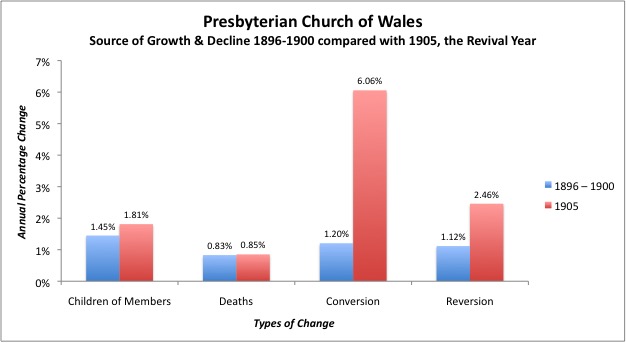
During the revival, the conversion rate jumps from 1.2% to 6%, which is a five-fold increase. Even though the reversion rate rises, it is clear that revival had a massive effect on conversion. Note that there was also a modest increase in the number of members’ children joining the church. However, the biggest effect of the revival is conversion from outside the church [3]. The work of the Holy Spirit in believers brings conversion into the church and, thus, church growth.
Even though revivals often come in short bursts, the cumulative effects of repeated short bursts would increase the average rate of conversion in those periods. There were at least 15 revivals in Wales between 1762 to 1862 [5]. So it is possible the high rate of 1.2% in conversion by 1900 was a residue from those earlier revival periods. Without further revivals, that conversion rate fell, figure 2, and had dropped to 0.46% by the 1960s [1]. Figure 2 shows the dramatic effect of the last Welsh Revival on conversion into the church. Similar increases were seen across the Welsh denominations.
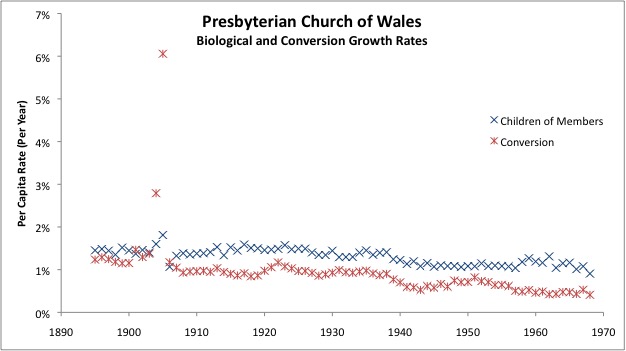
Previously [1], I introduced the first church decline hypothesis: Church decline is due to a lack of conversions. I now go further.
Second Church Decline Hypothesis
Church Decline is Caused by Lack of Revival
More specifically, while revivals occurred, the conversion rate was high, and the church grew rapidly. When revivals ended, the conversion rate fell, and the church subsequently declined. This can be demonstrated using known and estimated data.
Known Data
In order to investigate the effect of the revivals on church growth up to 1862, the proportion of the church with respect to the Welsh population is analysed using known data [4,6]. If it is assumed that the birth rate of the church is similar to society, and there are no documented reasons to believe otherwise, then any increase in the proportion of the church in society must mean there are conversions from outside the church. This will be true even if they have 100% child retention and no reversion [7]. Thus it will be possible to tell if revival correlates with conversion.
Figure 3 shows the proportional membership of the Welsh Presbyterians from 1860. It peaks in 1875 at 18.29% of Welsh society, after which the church is no longer keeping pace with the rapid population growth [8]. Population growth is smooth between 1850 to 1900, thus, it cannot be the source of the change in proportion, which is sharp in the 1870s, figure 3, as reflected in the raw membership (figure 5, see later). Thus the conversion rate appeared to fall significantly in the 1870s.
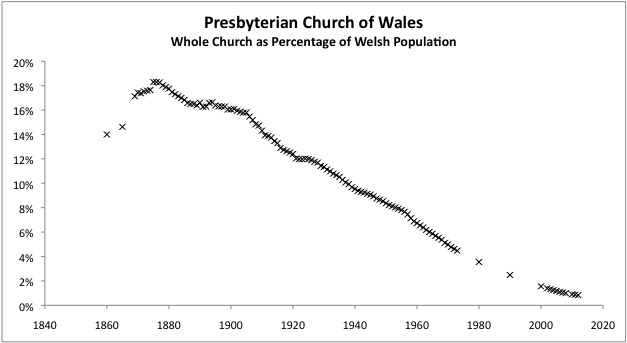
What are the alternatives? The sharp change could be due to a dramatic change in child retention. However, it does not change much during 1895 – 1968 and then it is quite smooth [1]. So this explanation is rejected.
Likewise, the change could be an increase in reversion. But with reversion at only just over 1% in 1896, there is not enough leverage for such a dramatic change. It would need a church where no-one was leaving 1800-1870, which is very unlikely.
Thus it is concluded the main change in the proportion of church members in society was a drop in conversion rate after the main period of revivals. It was not that conversion stopped; there had to be some to make up for 50% child retention and a 1% reversion rate [7]. But from the mid-1870s conversion must have fallen to a figure around 1.2% from one that had been higher, presumably due to the previous revivals.
Estimated Early Data
Although there is no data for the Welsh Presbyterian Church in the public domain prior to the 1860s, its rise from 1735 can be estimated by assuming it starts from zero and broadly follows the pattern of the related English Wesleyan movement [9]. Such an estimate is given in figure 4, with known revivals in Wales superimposed on the graph [5,10].

Revivals have been categorised as national, covering most of Wales, regional, about the size of a county, and local, confined to a village, town or a few churches. The national revivals are subdivided further into intense, where the revival spread through Wales very fast, lasting only a short period of time, and extended, where the spread across Wales took longer, perhaps due to communication speed in a rural environment. The date for the extended revival thus marks the start of the work, which may have lasted a number of years. The two intense revivals are the most famous, 1859/60 and 1904/5, as the large number of converts across all denominations, 110,000 and 100,000, respectively, came in a very short space of time and were thus better recorded [10,11]. These divisions could be contested but there are only proposed to give a flavour of the frequency and size of the revivals in Wales [5,10].
Figure 4 clearly shows that the proportional growth of the church correlates with the repeated outbreaks of revival, with the largest growth in the decade after the 1859/60 revival. Proportional growth means significant conversion growth. By contrast, proportional decline correlates with the lack of revivals. The turning point occurs from the 1870s onwards. The only major revival left is the 1904/5 one, but of all the revivals, this has the least effect on the church and was followed by decline – very much a revival out of its time [12]. Whatever went wrong in the church, it occurred decades before the last revival, around the 1870s.
Compare the same revivals with actual membership figures. The 1904/5 revival marks the end of growth for the church, the end of the age of universal revivals in Wales, ones that lead to national church growth. Again this graph makes clear that after the rapid growth following the 1859/60 revival, then growth slowed to a halt. There were now fewer revivals. The church was now failing to keep up with the rapidly growing population [8]. Growth picked up from 1890 but peaked in the last revival. Again growth only occurred as long as there were revivals.
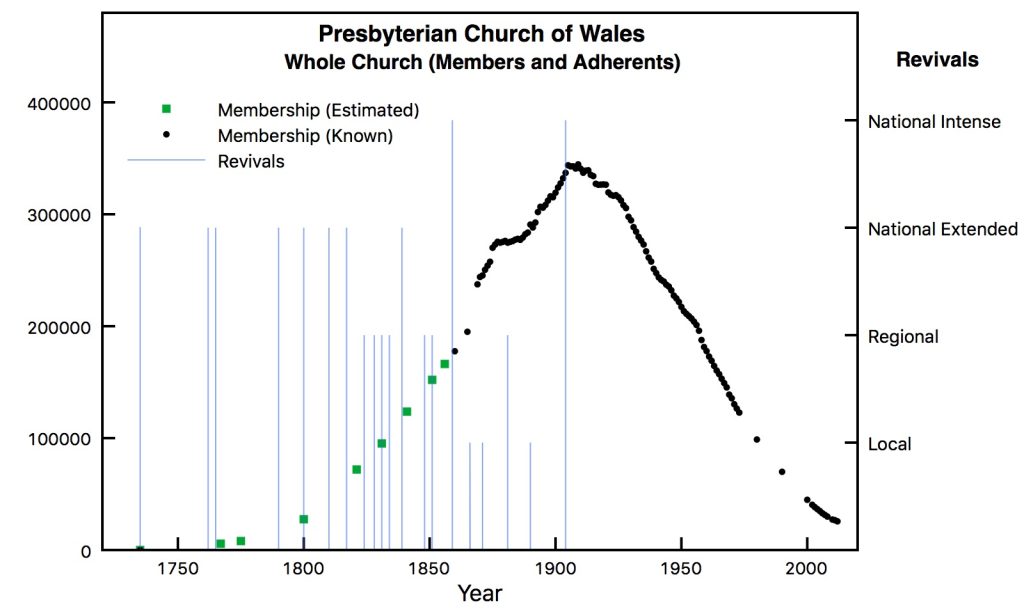
Compare Conversion Rates
Although the early figures for the Presbyterian Church are estimated, it is possible to construct a conversion rate for the period. The estimated figures indicate that the acceleration in growth starts around 1800, figure 5. In reality, it could have occurred later or earlier than this. What is known is that from 1767 to 1869, there was an average growth rate of 3.65%. If it were lower in some periods, it must have been higher in others.
Now assume a conservative estimate of deaths: 1% per year – similar to the 1890s and much lower than the national average due to the church having a young age profile; assume a leaving rate of 1.2% per year – similar to 1890s; assume a biological growth rate of 1.7% to 2.1% depending whether 50% to 60% of members’ children are retained, similar or better than 1890s.
Making these assumptions, the average conversion rate from 1767 to 1869 would have been 3.75% to 4.15%. This is much higher than the 1890s figure of 1.26%, implying that the conversion rate had waned once the effects of the last 19th century revival were no longer felt.
Note also the 3.75% to 4.15% conversion rate is an average figure. They will have been periods where this figure will have been lower and, of course, some higher – perhaps as high as the 6% of the 1904/5 revival. However, in that revival, the high conversion rate was temporary. From the 1760s to the 1870s the high conversion rate was ongoing. There is no doubt that internal migration and church planting would have helped keep the rate high. But such an increase of the presence of the church in new communities is one of the by-products of revival, so this feature is expected. Without conversions, new churches cannot be planted!
Conclusion
Thus I conclude that revival was the primary cause of the high conversion rate, which in turn was the cause of church growth.
Conversely, the lack of revivals after 1859-60 was the cause of the decline in conversion rate and, ultimately, the decline of the church. Again there is no difficulty in extending this conclusion across the other denominations. Thus it is clear the lack of revival is the primary cause of church’s decline, as without revival, the church cannot convert enough people to grow.
This now begs the question as to why revivals have ended or whether there were any other explanations for the decline, which might also explain the ending of revivals. I will leave a discussion of these for another blog.
Notes & References
[1] Blog: Church Decline Caused by Lack of Conversions
[2] By pre-20thcentury denominations, I mean Anglican, Presbyterian, Methodist and Congregational across England, Wales and Scotland. Decline is also true for Baptists but not to the same degree or pattern. Brethren and Salvation Army do not follow the standard decline pattern. Pentecostalism, which is largely growing, did not start until the 20th century. The post-1960 churches are a mixture of growth and decline.
[3] Revival is initially a work in believers, giving them an intense experience of the presence of God, a baptism of the Holy Spirit as at Pentecost. The result of the revival is that revived Christians are more effective at witnessing Christ to people. Thus, more people in the church catch the fire, and more people from outside the church are converted. Although passing on the fire to unbelievers and believers can explain much of the progress of a revival, which is why it has similar dynamics to the spread of the disease, there is nevertheless some mystery as well. Some people get an awareness of God just from being close to the locality of a revival, without having any contact with anyone. Some are filled with the Spirit or converted spontaneously. Others catch the fire by hearing about the revival by second-hand means such as media reports. See:
- Lloyd-Jones D.M. (1986). Revival, Marshall Pickering.
- Edwards B.H. (1990). Revival, Evangelical Press.
- Edwards J. (1984). On Revival, The Banner of Truth Trust.
[4] Currie, R., Gilbert, A. D., & Horsley, L. S. (1977). Churches and Churchgoers: Patterns of Church Growth in the British Isles since 1700. Oxford University Press, USA.
[5] Jones D.G. (2001). Favoured with Frequent Revivals: Revivals in Wales 1762-1862, The Heath Christian Trust.
[6] Williams J. (1985), Digest of Welsh Historical Statistics, Government Statistical Service HMSO.
[7] If the church’s child retention were similar to the known period then it would be 50-60%. Additionally, reversion would be around 1%. See previous blog [1]. Thus in a church growing proportionally there will be some conversions making up for these losses.
[8] The population of Wales is given in figure 6 using census data and other historical sources*. The early figures are less reliable than the later ones. The rapid rise in population occurs along with the industrial revolution and ceases after World War 1 with emigration. The reasons for the rapid 19th century rise are complex and will be touched on in a subsequent blog
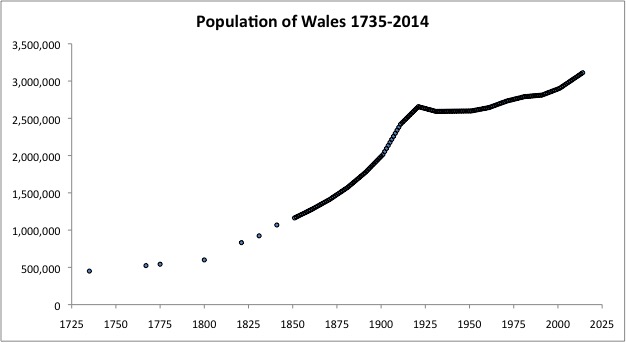
* Sources
- Britannica Wales.
- A Brief History of Wales
- BBC – Wales History
- A Short History of Wales – Stanford
- Roderick, F. and McCloskey, D.N. (1981). The Economic History of Britain Since 1700: Volume 1, Cambridge University Press.
- Wrigley, E.A. and Scofield, R.S. (1989). The Population History of England, 1541-1871: a reconstruction, Cambridge University Press.
- Office of National Statistics, Census Data.
[9] The Presbyterian Church of Wales were Calvinist Methodists and were a parallel movement in Wales, and initially in Welsh, to the English Methodists, who were largely Wesleyan in belief and organisation. Both were initially movements within the established Church of England and were not recognised as churches until the first generation had passed, 1790s-early1800s. Thus their spread can be expected to be similar.
I compared the figures of the Welsh and Wesleyan Methodists, where they were both known, and noted that their proportions of society were diverging. I extrapolated that divergence back to the 1700s using known data for the Wesleyan Methodists so that the Welsh Methodists were zero in 1735, the year the movement started.
[10] See the books:
- Evans, E. (1969). The Welsh Revival of 1904. Evangelical Press of Wales.
- Davies, E. (2004). The Beddgelert Revival, Bryntirion Press.
Compared with Jones [5], the number and duration of revivals are not easy to determine as the work spreads from region to region. The indicated date for many of the revivals is the year they start, according to [5,10], and they may extend for a number of years.
[11] Evans, E. (1979). Revival Comes to Wales, Evangelical Press of Wales.
[12] I would suggest the 1904/5 revival was not primarily about Wales but the world. Many missionary movements and revivals trace their origins to this Welsh Revival (see Gibbard). Pentecostalism both in the UK and the USA is directly linked to the revival (See Pike, Livesay, Synan, Bartleman), and is the fastest growing revival movement in history. The 1904/5 Welsh Revival was God’s way of bringing revival to the world!
- Gibbard, N. (2004). On the Wings of A Dove: The International Effects of the 1904-05 Revival, Evangelical Press.
- Pike, D. (2015). Azusa Street and the Welsh Revival,
- http://daibach-welldigger.blogspot.co.uk/2015/09/azuza-street-and-welsh-revival.html
- Livesay, J. (2000). When We Walk with the Lord, published by the author, New Zealand, ISBN 0-473-06831-1.
- Synan, V. (1997). The Holiness-Pentecostal Tradition, pp. 86-88, Eerdmans.
- Bartleman, F. (1980), [1925]. Azusa Street, ch 2, Logos International.
Tags: Calvinist Methodists, Conversion, Holy Spirit, Lloyd-Jones, Presbyterian Church of Wales